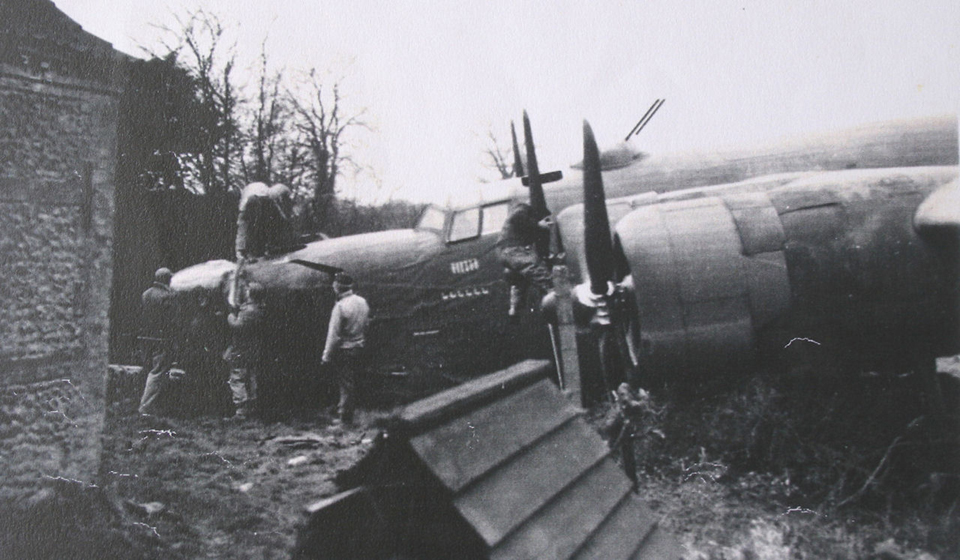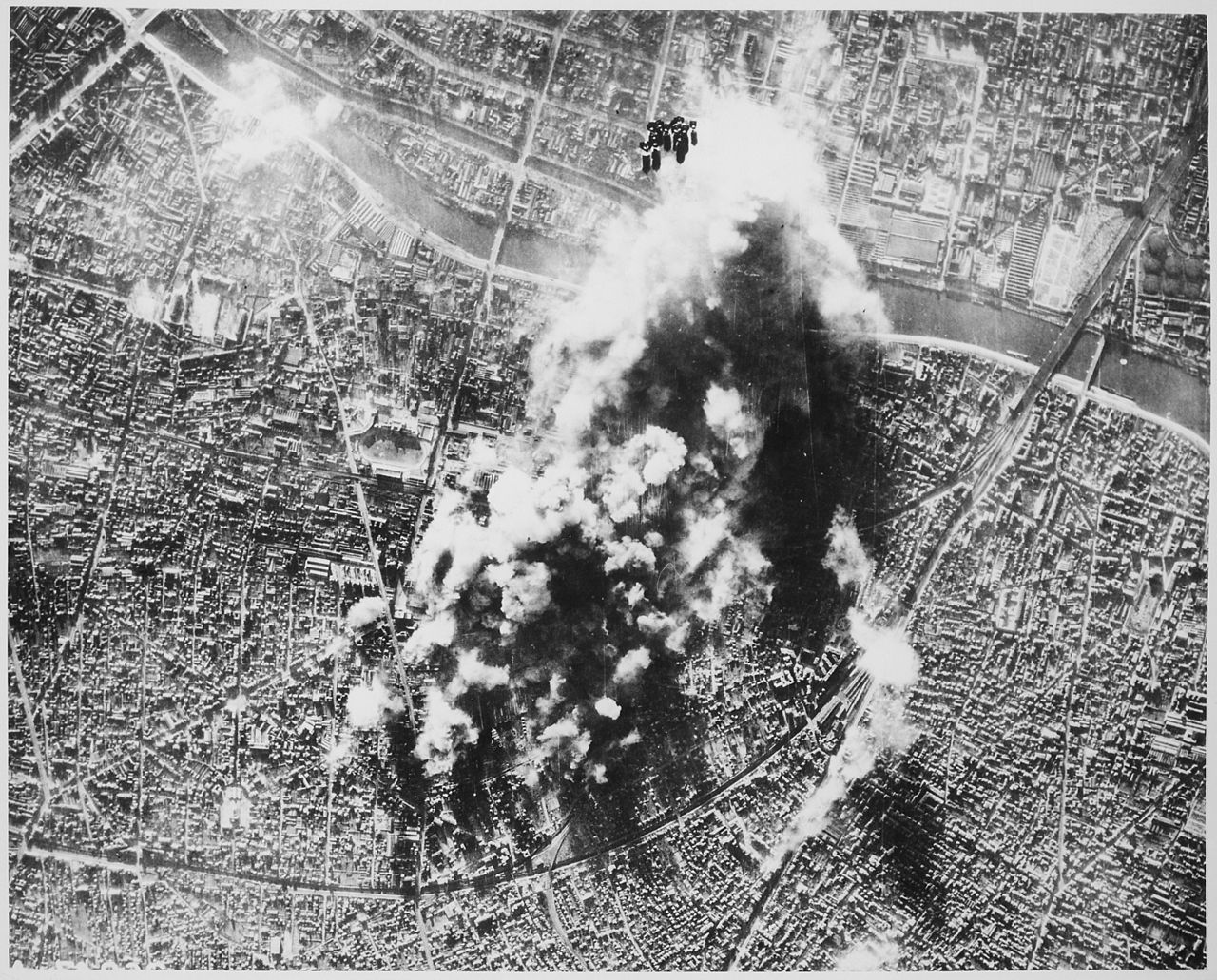Air Operations, Bismarcks
- 3rd Light Bomb Group A-20s support US Army ground troops at Arawe.
- When a small force of Japanese aircraft attempts to attack the Arawe beachhead at about 1315 hours, it is intercepted by nearly 50 V Fighter Command P-40s and P-47s. In the ensuing 10 minute action, 8th Fighter Group P-40s down 2 fighters, and 348th Fighter Group P-47s down 8 D3A 'Oscar' fighters and 2 A6M Zeros.
Air Operations, CBI
CHINA- 6 11th Medium Bomb Group B-25s attack Yangtze River traffic near Anking and Lu-kuan. 2 other B-25s attack a passenger ship in the Hainan Strait.
- 25 308th Heavy Bomb Group B-24s attack rail facilities at Lampang.
Air Operations, Europe
8th AIR FORCEFRANCE:
- 200 VIII Bomber Command B-17s and 144 B-24s attack the Bordeaux/Merignac, Cognac/Chateaubernard, and St.-Jean-d'Angely Airdromes.
- 120 VIII Bomber Command B-17s attack aircraft-industry targets around Paris.
- 25 bombers are lost to enemy fire, 15 are lost due to different operational issues
- Escort and support for the heavy bombers is provided by 74 P-38s, 441 P-47s, and 33 P-51s, which down 9 Luftwaffw fighters over France between 1030 and 1400 ours.
- 4 USAAF fighter are lost; 2 pilots are lost
FRANCE:
- Approximately 200 IX Bomber Command B-26s attack V-weapons sites along the Channel coast.
ITALY:
- MAAF fighters and fighter-bombers support the British 8th Army with attacks against German Army artillery and troop displacements all along the battle line.
- XII Air Support Command A-36s attack gun emplacements and the town area at Formia.
Air Operations, New Guinea
More than 150 V Bomber Command B-24s, B-25s, and B-26s attack targets in and around Alexishafen, Bogadjim, and Madang.
[CBI
BURMAElements of the 113th Regiment relieve the 2nd Battalion, 112th Regiment, as the fighting continues between the Chinese 38th Division and Japanese forces in the Hukawng valley, north of Yupbang Ga in northern Burma.
[Eastern Front
The Soviets recapture Zhitomir. Farther north there is increased activity west of Nevel and south of Vitebsk where the road to Orsha is cut. Vitebsk is now almost surrounded but fierce defense by the Wehrmacht prevents them from capturing it.
Luftwaffe strength on the Eastern Front stands at 1,683 combat aircraft, whereas Red Army Military Aviation (VVS) can deploy 8,818 combat aircraft, with a further 313 held in reserve.
CENTRAL SECTORThe IX Corps of the 3rd Panzer Army is again under attack near Nevel while the West Front presses the VI Corps back between Orsha and Vitebsk, cutting the road between the towns.
There and estimated 360,000 armed Soviet partisans operating in Belorussia.
SOUTHERN SECTORThe 18th Army and 3rd Guards Tank Army recapture Zhitomir. The XXIV Panzer and VII Corps are reeling back along the road to Vinnitsa, split from the 4th Panzer by a 50-mile hole in the line. Remnants of the XIII Corps fight in isolation around Zhitomir while fifty miles to the north the LIX Corps is fighting around Korosten and Olevsk. The battered XLVIII Panzer Corps, having suffered heavy losses as it rushed from one threatened sector to another, is retreating in the Berdichev-Kazatin area. The XLVIII Panzer Corps destroys 67 Red Army tanks in defensive fighting at Berdichev. The Germans capture a substantial number of enemy prisoners, some of whom are boys aged between 13 and 16. At this time the panzer corps has around 100-150 tanks in working order - equivalent to a full-strength panzer division.
THE RED ARMYAt the end of 1943 the Red Army has grown to become the most powerful field army in the world. Its strength has risen to 5,570,000 soldiers in the first echelon, with a further 419,000 in reserve. The armies at the front are equipped with 5,600 tanks and Su's and 90,000 arty pieces, while the air armies have more than 8,800 aircraft at their disposal together with 480,000 personnel. The Soviet Navy remains a minor arm with just 260,000 men, namy of who served on land with the marine brigades.
However, there are signs that the supposed bottomless supply of men is nearing its end. Already there are 15- and 16-year-ole boys serving with the combat units and many 'liberated' citizens in the Ukraine are pressed into service. Levels of equipment has risen significantly though, the Red Army being better equipped than ever before. It is now a truly modern, mobile army. Mechanization of the infantry is due largely to the Lend Lease trucks supplied by the Western Allies, and the increased mobility of the ordinary rifle divisions will give the offensives of 1944 and '45 a rapidity not seen before in the east.
Perhaps the most important development though is the Stavka's ability to coordinate its forces effectively. No longer did tanks operate as infantry support weapons, the roles having been reversed. Attacks are now preceded by massed ary fire and infantry attacks, which break through the main German lines of resistance. Once this has been achieved the still intact armored forces are introduced into the battle to thrust behind the enemy lines. It has been along and hard lesson but the Stavka has learned it well. Furthermore, the air force is now acting in support of the ground forces, gaining superiority over the battlefield. Against such well coordinated all-arms attacks the Germans, with only limited reserves if any at all, can not hope to hold back the tide of the Russian forces.
THE OSTHEERThe Ostheer has suffered crippling lossed during 1943 and, despite receiving new equipment, lacked the strength of numbers to compete with the Red Army. The new generation of Tiger and Panther tanks are greatly superior to the Russian models currently in the field but lack of numbers is a real problem. Equipment losses generally have been high and while the Red Army becomes increasingly mechanized the Germans have to rely more upon horses for their transport needs. Once the Allied Combined Bomber Offensive really begins to bite in 1944, the shortage of equipment is made far worse by a shortage of fuel. Manpower though is still the biggest problem faced by the German army, the shortgall of combat infantry growing larger every month as casualties increase.
During December the German armies lose 1 SS motorized division and 13 infantry divisions from their order of battle while receinving 1 parachute and 1 infantry division in return. Germany's allies have also been hit particularly badly during the course of the year, the Italians and Hungarians having their armies in the east destroyed during the first quarter. The Rumanians, though still present, have far fewer men in the field following the disaster at Stalingrad and can not be relied upon to hold the line when faced by the Russian troops. Since June 1941 Germany has lost nearly 3,000,000 men in the east. At the end of 1943 the Ostheer has 24 panzer, 9 panzer grenadier and 140 infantry divisions in the line, while Rumania has 9 divisions, Hungary 9, Slovakia 1, Spain 1 and the Finns 16 divisions.
PRODUCTIONBoth sides continue to produce large amounts of equipment, German production figures rising dramatically during the latter part of 1943 as Armaments Minister Speer's improvements to the industrial might of the Reich begin to have an impact. Germany has manufactured 12,063 panzers and assault guns and 46,100 arty pieces, 74,181 transport vehicles and 25,527 aircraft during 1943, while the Soviets manufacture 24,089 tanks and Su's, 130,000 arty pieces, 38,845 aircraft and produced or received through Lend Lease 45,000 transport vehicles. The Germans though are supplying increasing numbers of weapons and men to the western regions of the Reich, the fighting in Italy and the build up in France tying down more and more divisions.
[Italy
As the year ends both 5th and 8th Armies are battering wearily and almost fruitlessly against the German defenses. On the western front, the US 5th Army sector, the American 6th Inf Regt replaces the 15th on Monte Lungo. Other units try unsuccessfully to dislodge the Germans from their positions east of Acquafondata. On the British 8th Army front there is fighting in the Adriatic coast area around Ortona and Orsogna. Montgomery leaves the 8th Army.
Casualties resulting from Allies air raids on the Italian peninsula and islands over the past 3 months amount to 6,500 dead, about 11,000 wounded, with 3,500 buildings destroyed and 10,000 damaged.
[Mediterranean
The British minesweeper Clacton sinks on a mine off Corsica with the loss of 33 of her crew.
[New Britain
Maj-Gen William H. Rupertus send the following message to Lt-Gen Krueger: "Situation well in hand due to fighting spirit of troops, the usual Marine luck and the help of God." 5th Air Force A-20 Havocs attack Japanese troops around Cape Gloucester. The 3/5 Marines complete their landing and relieve the 2/7 Marines, which now becomes the division reserve.
Japanese aircraft attempting to attack marines near Arawe are attacked by nearly 50 P-40s and P-47 Thunderbolts. The Japanese lose 12 aircraft to the American fighters.
[New Guinea
The Allied troops form the occupation of Saidor embark at Goodenough Island northeast of New Guinea.
[Pacific
The US submarine Greenling (SS-213) sinks the Japanese transport Shoho Maru (1936t) in the Eastern Carolines.
[Solomons
The year ends with the US haveing established strong positions on Bougainville, despite determined Japanese opposition in the island's interior. Empress Augusta Bay is now a fully operational US Navy base with 3 airstrips on the island.
[United States, Home Front
Sergei Rachmaninoff, the composer, dies at age 69.
[Images from December 31, 1943
|
|
Deceased US Soldier in San Pietro |
 |

